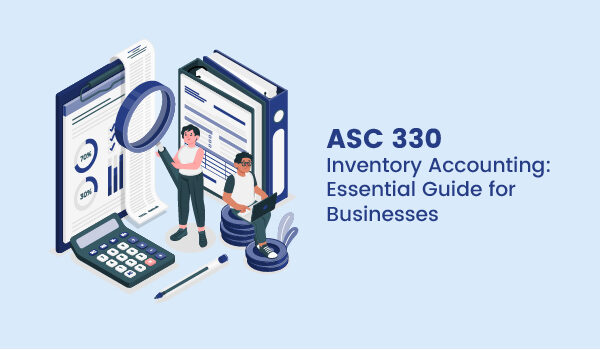ASC 330 – Inventory Accounting: Essential Guide for Businesses

ASC 330 – Inventory is a critical accounting standard for businesses that manage inventory, whether in manufacturing, retail, or distribution. It provides clear guidelines for valuing inventory, ensuring that companies report accurate and reliable financial statements. From understanding the different inventory costing methods like FIFO and LIFO to applying the "Lower of Cost or Market" rule, ASC 330 affects how businesses calculate and report their inventory’s value.
In this article, we will help you navigate these essential concepts, ensure compliance, and make smarter decisions that enhance your financial reporting. Let’s explore everything you need to know about ASC 330!
What is ASC 330 – Inventory?
ASC 330, part of the Accounting Standards Codification (ASC), is the accounting standard issued by the Financial Accounting Standards Board (FASB) that governs how businesses should handle the accounting and reporting of inventory. This standard is vital for companies that hold inventory, ensuring the accurate valuation and presentation of their stock on financial statements.
ASC 330 outlines the methods businesses should use to value inventory and how to report changes in its value. By providing clear guidelines, the standard helps ensure that financial statements accurately reflect the true cost of goods held by the business. This, in turn, affects everything from profit margins to tax liabilities.
Why is ASC 330 Important?
For any company dealing with inventory, ASC 330 serves as the backbone of proper financial reporting. Without it, companies could potentially misstate the value of their inventory, leading to inaccurate financial results. By adhering to ASC 330, businesses ensure that their financial statements are both reliable and consistent, which is crucial for investors, stakeholders, and regulatory compliance.
Key Inventory Valuation Methods Under ASC 330
One of the most important aspects of ASC 330 is its guidance on inventory valuation methods. These methods determine how inventory is priced and, ultimately, how it appears on a company’s balance sheet. Let's break down the most common methods used:
1. First-In, First-Out (FIFO)
FIFO assumes that the first items purchased or produced are the first ones sold or used. This method works well when the prices of inventory are rising because it assigns the lower, earlier costs to the cost of goods sold (COGS), leaving the higher-priced inventory on the balance sheet.
Example: If a company purchases inventory at $10 per unit and later buys more at $15 per unit, under FIFO, the inventory sold would be recorded at the $10 rate, and the remaining inventory will be valued at $15.
2. Last-In, First-Out (LIFO)
Under LIFO, the last items purchased or produced are considered the first ones to be sold. This method can be beneficial for companies in industries where prices are consistently rising, as it results in higher COGS and lower taxable income.
Example: If the company in the FIFO example purchased more inventory at $15 per unit, under LIFO, the $15 units would be considered sold first, with the remaining inventory valued at the earlier $10 price.
3. Weighted-Average Cost Method
The weighted-average method averages the cost of all units available for sale during the period. This method smooths out price fluctuations and provides a more stable valuation for inventory, especially useful for businesses with large volumes of homogenous goods.
Example: If a company buys 100 units at $10 and 100 units at $15, the average cost per unit would be ($10 + $15) / 2 = $12.50 per unit. This average is then used for both COGS and remaining inventory.
4. Specific Identification
This method is used for unique or expensive items where each unit is easily identifiable (e.g., luxury goods, vehicles, or real estate). Each item’s cost is directly assigned to it, which makes this method highly accurate but also more labor-intensive.
Example: If a car dealership sells a specific car, the cost assigned to that car is exactly the price the dealership paid for it, ensuring precise inventory valuation.
The Lower of Cost or Market (LCM) Rule Explained
One of the most important concepts in ASC 330 is the Lower of Cost or Market (LCM) rule. This rule requires businesses to write down their inventory to the lower of its cost or its market value when the market value of the inventory drops below its cost.
The goal is to ensure that inventory is not overstated on financial statements, particularly when the market conditions cause a reduction in the value of goods held.
What is Market Value?
The term "market value" under ASC 330 refers to the replacement cost of the inventory, but with two important limits:
- Net realizable value: The estimated selling price minus the costs to sell.
- Net realizable value minus a normal profit margin: Ensures that businesses do not overstate inventory by assuming excessive profit.
How the LCM Rule Works?
When the cost of inventory exceeds its market value, the business must recognize a loss by writing down the inventory to its market value. This process affects both the income statement (by recognizing the loss) and the balance sheet (by lowering the reported value of inventory).
Example: If a company bought inventory at $100 per unit, but due to market conditions, it can only sell it for $80 per unit, the company would write down the inventory to $80. The $20 difference would be recognized as a loss.
Why is the LCM Rule Important?
This rule prevents businesses from overvaluing their assets and ensures that financial statements provide a more accurate reflection of the company’s economic situation. It is particularly useful during times of fluctuating market conditions, such as when the value of raw materials or finished goods declines.
How to Adjust Inventory Valuation: Write-Downs and Losses
Adjusting the value of inventory to reflect declines in market value is an essential part of ASC 330 compliance. When market value falls below cost, businesses are required to write down inventory, and these write-downs must be carefully accounted for in the company’s financial records.
When Should Inventory Be Written Down?
A write-down should occur when the market value of the inventory falls below its cost. This can happen due to several factors, including changes in market demand, obsolescence, or damage to inventory.
How to Account for Write-Downs
Once inventory is written down, the loss is typically recorded as an expense on the income statement. This reduction in inventory value also lowers the balance of assets on the balance sheet.
Impact on Profitability
Inventory write-downs directly affect a company's profitability, as they are considered expenses. This can reduce reported profits, potentially affecting tax obligations and performance metrics such as earnings per share (EPS).
Presentation and Disclosure Requirements for ASC 330
To ensure transparency and maintain compliance with ASC 330, businesses are required to disclose specific details about their inventory in their financial statements.
Inventory Presentation on Financial Statements
ASC 330 outlines how inventory should be presented on the balance sheet. Inventory is classified as a current asset, and it must be reported at the lower of cost or market value.
Required Disclosures
Companies must disclose their inventory valuation method (e.g., FIFO, LIFO, or weighted average) and any changes in accounting methods. If a write-down occurs, it must be disclosed, along with the reasons for the reduction and the amount of the write-down.
For companies that use LIFO, additional disclosures are required to provide more clarity on how LIFO impacts the financial statements, including the LIFO reserve, which represents the difference between the cost of inventory under LIFO and the cost using FIFO.
ASC 330 vs. IFRS: Key Differences in Inventory Accounting
When it comes to global accounting standards, many businesses operate under the guidelines of both ASC 330 (U.S. GAAP) and International Financial Reporting Standards (IFRS). While both standards aim to ensure accurate and transparent financial reporting, there are key differences between them in how inventory is valued and presented.
Inventory Valuation Methods
One of the most notable differences between ASC 330 and IFRS is in the inventory valuation methods allowed. ASC 330 permits the use of LIFO, whereas IFRS does not. Under IFRS, businesses are restricted to using FIFO or the weighted average cost method.
FIFO and LIFO Under ASC 330: U.S. businesses may use FIFO and LIFO to manage their inventory accounting. LIFO can be advantageous for tax purposes when prices are rising because it results in higher cost of goods sold and, consequently, lower taxable income.
FIFO Only Under IFRS: IFRS does not allow LIFO because it can result in outdated inventory valuations. This can lead to discrepancies in financial statements when compared to U.S. GAAP, particularly in industries with inflationary trends.
Market Value in Inventory Valuation
While both ASC 330 and IFRS require inventory to be valued at the lower of cost or market value, the definition of market value can differ slightly. Under ASC 330, market value refers to the replacement cost of the inventory, but with limits based on net realizable value and normal profit margins. IFRS, on the other hand, places greater emphasis on net realizable value alone.
Impact on Global Businesses
For businesses that operate internationally, understanding these differences is crucial. Companies that follow U.S. GAAP must adjust their accounting practices if they are required to report under IFRS for operations outside the U.S. This can involve significant changes in how inventory is valued, which can have implications for profitability, taxation, and financial reporting consistency.
Recent Updates and Amendments to ASC 330
ASC 330 is a living standard, meaning it undergoes updates and amendments from time to time. Staying informed about these changes is essential for businesses to maintain compliance and ensure that their inventory reporting is accurate.
Amendments and Changes
In recent years, there have been changes to inventory accounting rules under ASC 330, including updates aimed at simplifying the measurement of inventory. For example, businesses can now use the lower of cost or market method with fewer restrictions, helping to streamline inventory valuation.
Effective Dates for New Rules
It's important to stay updated on the effective dates of these amendments. For companies adopting new rules, the transition period is critical. These rules usually specify a deadline by which businesses must begin applying the new guidance to their inventory reporting, ensuring they are in line with the latest accounting requirements.
Practical Tips for Implementation
For businesses transitioning to new inventory standards, it's essential to review current accounting methods and practices. Companies may need to revise their inventory accounting policies, update their software systems, and train their accounting teams to apply new methods correctly.
Summary
ASC 330 – Inventory is a vital standard for any company involved in inventory management. By understanding the key concepts, such as inventory valuation methods, the Lower of Cost or Market rule, and the necessary disclosures, businesses can ensure compliance with U.S.
GAAP while optimizing their financial reporting processes. Whether you're dealing with rising costs, fluctuating market conditions, or transitioning to new accounting methods, staying on top of ASC 330 will help maintain transparency and accuracy in your financial statements.
Remember, accurate inventory accounting not only helps maintain regulatory compliance but also plays a crucial role in decision-making and business strategy. Take the time to review your inventory practices, and ensure that you are following the best methods to report your inventory values accurately.
- Phone Number: 917-415-6166
- Email Address: njamil@njcpausa.com
- Address: 51 Atlantic Avenue, Suite 202, Floral Park, NY 11001








